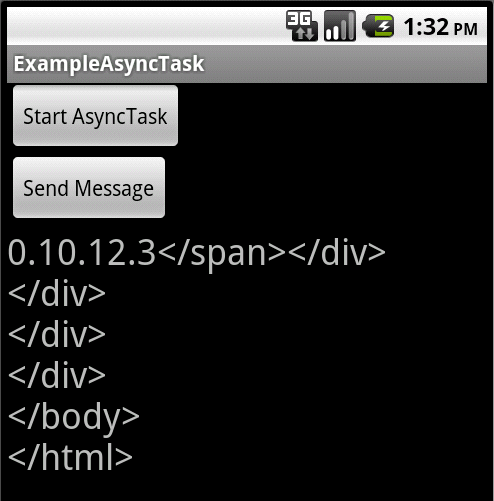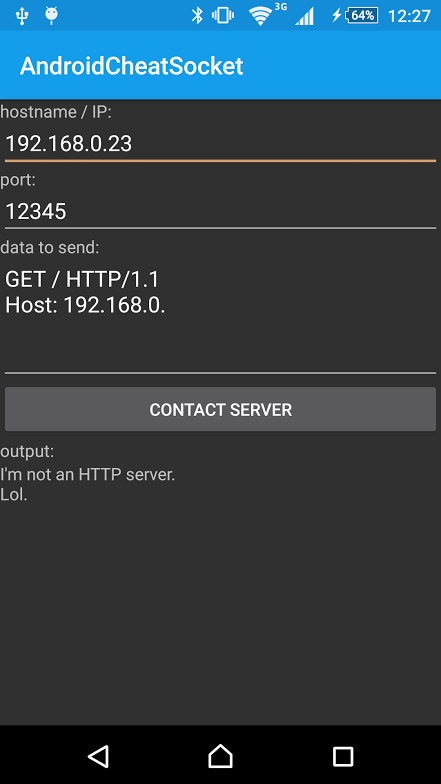Exemple: socket de réseau bidirectionnel Android utilisant AsyncTask
la plupart des exemples de socket réseau que J'ai trouvé pour Android étaient un directionnel seulement. J'avais besoin d'une solution pour un flux de données bidirectionnel. J'ai finalement appris l'AsyncTask. Cet exemple montre comment récupérer des données à partir d'une socket et les y renvoyer. En raison de la nature de blocage d'une socket qui reçoit des données, ce blocage doit fonctionner dans un thread autre que le thread UI.
Pour exemple, ce code se connecte à un serveur web. Appuyer sur le bouton "Démarrer AsyncTask"" bouton va ouvrir la prise. Une fois la socket ouverte, le serveur web attend une requête. En appuyant sur le bouton" envoyer un Message", vous enverrez une requête au serveur. Toute réponse du serveur sera affichée dans TextView. Dans le cas de http, un serveur web se déconnectera du client une fois que toutes les données auront été envoyées. Pour les autres flux de données TCP, la connexion restera en place jusqu'à ce qu'un côté déconnecter.
Capture d'écran:

AndroidManifest.xml:
<?xml version="1.0" encoding="utf-8"?>
<manifest xmlns:android="http://schemas.android.com/apk/res/android"
package="com.exampleasynctask"
android:versionCode="1"
android:versionName="1.0">
<uses-sdk android:minSdkVersion="8" />
<uses-permission android:name="android.permission.INTERNET" />
<application android:icon="@drawable/icon" android:label="@string/app_name">
<activity android:name=".MainActivity"
android:label="@string/app_name">
<intent-filter>
<action android:name="android.intent.action.MAIN" />
<category android:name="android.intent.category.LAUNCHER" />
</intent-filter>
</activity>
</application>
</manifest>
reslayoutmain.xml:
<?xml version="1.0" encoding="utf-8"?>
<LinearLayout xmlns:android="http://schemas.android.com/apk/res/android"
android:orientation="vertical"
android:layout_width="fill_parent"
android:layout_height="fill_parent"
>
<Button android:id="@+id/btnStart" android:layout_width="wrap_content" android:layout_height="wrap_content" android:text="Start AsyncTask"></Button>
<Button android:id="@+id/btnSend" android:layout_width="wrap_content" android:layout_height="wrap_content" android:text="Send Message"></Button>
<TextView android:id="@+id/textStatus" android:textSize="24sp" android:layout_width="fill_parent" android:layout_height="wrap_content" android:text="Status Goes Here" />
</LinearLayout>
srccom.exampleasynctaskMainActivity.java:
package com.exampleasynctask;
import java.io.IOException;
import java.io.InputStream;
import java.io.OutputStream;
import java.net.InetSocketAddress;
import java.net.Socket;
import java.net.SocketAddress;
import android.app.Activity;
import android.os.AsyncTask;
import android.os.Bundle;
import android.util.Log;
import android.view.View;
import android.view.View.OnClickListener;
import android.widget.Button;
import android.widget.TextView;
public class MainActivity extends Activity {
Button btnStart, btnSend;
TextView textStatus;
NetworkTask networktask;
@Override
public void onCreate(Bundle savedInstanceState) {
super.onCreate(savedInstanceState);
setContentView(R.layout.main);
btnStart = (Button)findViewById(R.id.btnStart);
btnSend = (Button)findViewById(R.id.btnSend);
textStatus = (TextView)findViewById(R.id.textStatus);
btnStart.setOnClickListener(btnStartListener);
btnSend.setOnClickListener(btnSendListener);
networktask = new NetworkTask(); //Create initial instance so SendDataToNetwork doesn't throw an error.
}
private OnClickListener btnStartListener = new OnClickListener() {
public void onClick(View v){
btnStart.setVisibility(View.INVISIBLE);
networktask = new NetworkTask(); //New instance of NetworkTask
networktask.execute();
}
};
private OnClickListener btnSendListener = new OnClickListener() {
public void onClick(View v){
textStatus.setText("Sending Message to AsyncTask.");
networktask.SendDataToNetwork("GET / HTTP/1.1rnrn");
}
};
public class NetworkTask extends AsyncTask<Void, byte[], Boolean> {
Socket nsocket; //Network Socket
InputStream nis; //Network Input Stream
OutputStream nos; //Network Output Stream
@Override
protected void onPreExecute() {
Log.i("AsyncTask", "onPreExecute");
}
@Override
protected Boolean doInBackground(Void... params) { //This runs on a different thread
boolean result = false;
try {
Log.i("AsyncTask", "doInBackground: Creating socket");
SocketAddress sockaddr = new InetSocketAddress("192.168.1.1", 80);
nsocket = new Socket();
nsocket.connect(sockaddr, 5000); //10 second connection timeout
if (nsocket.isConnected()) {
nis = nsocket.getInputStream();
nos = nsocket.getOutputStream();
Log.i("AsyncTask", "doInBackground: Socket created, streams assigned");
Log.i("AsyncTask", "doInBackground: Waiting for inital data...");
byte[] buffer = new byte[4096];
int read = nis.read(buffer, 0, 4096); //This is blocking
while(read != -1){
byte[] tempdata = new byte[read];
System.arraycopy(buffer, 0, tempdata, 0, read);
publishProgress(tempdata);
Log.i("AsyncTask", "doInBackground: Got some data");
read = nis.read(buffer, 0, 4096); //This is blocking
}
}
} catch (IOException e) {
e.printStackTrace();
Log.i("AsyncTask", "doInBackground: IOException");
result = true;
} catch (Exception e) {
e.printStackTrace();
Log.i("AsyncTask", "doInBackground: Exception");
result = true;
} finally {
try {
nis.close();
nos.close();
nsocket.close();
} catch (IOException e) {
e.printStackTrace();
} catch (Exception e) {
e.printStackTrace();
}
Log.i("AsyncTask", "doInBackground: Finished");
}
return result;
}
public void SendDataToNetwork(String cmd) { //You run this from the main thread.
try {
if (nsocket.isConnected()) {
Log.i("AsyncTask", "SendDataToNetwork: Writing received message to socket");
nos.write(cmd.getBytes());
} else {
Log.i("AsyncTask", "SendDataToNetwork: Cannot send message. Socket is closed");
}
} catch (Exception e) {
Log.i("AsyncTask", "SendDataToNetwork: Message send failed. Caught an exception");
}
}
@Override
protected void onProgressUpdate(byte[]... values) {
if (values.length > 0) {
Log.i("AsyncTask", "onProgressUpdate: " + values[0].length + " bytes received.");
textStatus.setText(new String(values[0]));
}
}
@Override
protected void onCancelled() {
Log.i("AsyncTask", "Cancelled.");
btnStart.setVisibility(View.VISIBLE);
}
@Override
protected void onPostExecute(Boolean result) {
if (result) {
Log.i("AsyncTask", "onPostExecute: Completed with an Error.");
textStatus.setText("There was a connection error.");
} else {
Log.i("AsyncTask", "onPostExecute: Completed.");
}
btnStart.setVisibility(View.VISIBLE);
}
}
@Override
protected void onDestroy() {
super.onDestroy();
networktask.cancel(true); //In case the task is currently running
}
}
3 réponses
SendDataToNetwork la tâche s'exécute dans le thread principal de l'interface utilisateur, ce qui signifie qu'elle va planter un Honeycomb ou une application supérieure à cause de NetworkOnMainThreadException Fatale. Voici ce que mon SendDataToNetwork ressemble pour éviter ce problème:
public boolean sendDataToNetwork(final byte[] cmd) {
if (_nsocket.isConnected()) {
Log.i(TAG, "SendDataToNetwork: Writing received message to socket");
new Thread(new Runnable() {
public void run() {
try {
_nos.write(cmd);
} catch (Exception e) {
e.printStackTrace();
Log.i(TAG, "SendDataToNetwork: Message send failed. Caught an exception");
}
}
}).start();
return true;
}
Log.i(TAG, "SendDataToNetwork: Cannot send message. Socket is closed");
return false;
}
SendDataToNetwork ne fonctionne pas sur le même thread que doInBackground(). Il y a une possibilité que SendDataToNetwork commencerait à envoyer des données avant que la socket ne soit prête.
Pour éviter tout cela, à utiliser SendDataToNetwork pour sauvegarder les données et signaler au thread background que les données sont prêtes à être envoyées.
Puisqu'il est possible que l'utilisateur puisse appuyer sur le bouton plusieurs fois, pendant que les anciennes données sont encore envoyées, vous devriez avoir synchronisé la file d'attente à L'intérieur de NetworkTask. Alors:
- Background thread configure la connexion socket et va ensuite au sleep (via wait ()).
- Sur le bouton de presse,
SendDataToNetworkajoute des données à la file d'attente et réveille le thread de fond (vianotify()). - lorsque le thread background se réveille, il vérifie d'abord le
finishdrapeau. S'il est réglé, il ferme les connexions et les sorties. Si ce n'est pas le cas, il lit les données de la file d'attente, les envoie au réseau et se rendort. - Vous devriez avoir
finish()méthode qui définit unfinishdrapeau (variable atomique, comme booléen) et se réveille le thread d'arrière-plan. C'est une façon de sortir avec élégance du fil d'arrière-plan.
regardez comment se fait la synchronisation des threads: http://www.jchq.net/tutorial/07_03Tut.htm
exemple plus interactif
similaire à L'OP, mais vous pouvez contrôler l'hôte, le port et le message + il y a une notification d'erreur popup si la connexion a échoué.
Utilisation 1:
- Android et un bureau Linux sur un réseau local
- trouver L'IP du bureau avec
ifconfig - exécuter
netcat -l 12345sur un terminal - sur Android, remplissez le L'adresse IP de l'ordinateur de bureau
- cliquez sur contacter le serveur
- sur le terminal, tapez la réponse, puis appuyez sur
Ctrl + D - il apparaît sur le
output:
Utilisation 2:
- nom d'hôte
google.com - port
80 - Message:
"GET / HTTP/1.1\r\nHost: google.com\r\n\r\n"
notez que certains serveurs HTTP ne fermeront pas après la réponse en attendant d'autres requêtes, et que l'application sera suspendue jusqu'à leur expiration. Tel les serveurs s'attendent à ce que vous parsliez le Content-Width tête et fermez-vous.
Si la connexion échoue, un message d'alerte est affiché à l'utilisateur dans une boîte de dialogue.
Code
Ajouter AndroidManifest.xml:
<uses-permission android:name="android.permission.INTERNET" />
et l'activité principale est:
import android.app.Activity;
import android.app.AlertDialog;
import android.app.IntentService;
import android.content.DialogInterface;
import android.content.Intent;
import android.os.AsyncTask;
import android.os.Bundle;
import android.util.Log;
import android.view.View;
import android.widget.Button;
import android.widget.EditText;
import android.widget.LinearLayout;
import android.widget.ScrollView;
import android.widget.TextView;
import java.io.IOException;
import java.io.InputStream;
import java.io.OutputStream;
import java.net.Socket;
public class Main extends Activity {
final static String TAG = "AndroidCheatSocket";
@Override
protected void onCreate(Bundle savedInstanceState) {
super.onCreate(savedInstanceState);
final LinearLayout linearLayout = new LinearLayout(this);
linearLayout.setOrientation(LinearLayout.VERTICAL);
TextView textView;
final String defaultHostname = "192.168.0.";
textView = new TextView(this);
textView.setText("hostname / IP:");
linearLayout.addView(textView);
final EditText hostnameEditText = new EditText(this);
hostnameEditText.setText(defaultHostname);
hostnameEditText.setSingleLine(true);
linearLayout.addView(hostnameEditText);
textView = new TextView(this);
textView.setText("port:");
linearLayout.addView(textView);
final EditText portEditText = new EditText(this);
portEditText.setText("12345");
portEditText.setSingleLine(true);
linearLayout.addView(portEditText);
textView = new TextView(this);
textView.setText("data to send:");
linearLayout.addView(textView);
final EditText dataEditText = new EditText(this);
dataEditText.setText(String.format("GET / HTTP/1.1\r\nHost: %s\r\n\r\n", defaultHostname));
linearLayout.addView(dataEditText);
final TextView replyTextView = new TextView(this);
final ScrollView replyTextScrollView = new ScrollView(this);
replyTextScrollView.addView(replyTextView);
final Button button = new Button(this);
button.setText("contact server");
button.setOnClickListener(new View.OnClickListener() {
@Override
public void onClick(View view) {
button.setEnabled(false);
new MyAsyncTask(Main.this, replyTextView, button).execute(
hostnameEditText.getText().toString(),
portEditText.getText().toString(),
dataEditText.getText().toString());
}
});
linearLayout.addView(button);
textView = new TextView(this);
textView.setText("output:");
linearLayout.addView(textView);
linearLayout.addView(replyTextScrollView);
this.setContentView(linearLayout);
}
private class MyAsyncTask extends AsyncTask<String, Void, String> {
Activity activity;
Button button;
TextView textView;
IOException ioException;
MyAsyncTask(Activity activity, TextView textView, Button button) {
super();
this.activity = activity;
this.textView = textView;
this.button = button;
this.ioException = null;
}
@Override
protected String doInBackground(String... params) {
StringBuilder sb = new StringBuilder();
try {
Socket socket = new Socket(
params[0],
Integer.parseInt(params[1]));
OutputStream out = socket.getOutputStream();
out.write(params[2].getBytes());
InputStream in = socket.getInputStream();
byte buf[] = new byte[1024];
int nbytes;
while ((nbytes = in.read(buf)) != -1) {
sb.append(new String(buf, 0, nbytes));
}
socket.close();
} catch(IOException e) {
this.ioException = e;
return "error";
}
return sb.toString();
}
@Override
protected void onPostExecute(String result) {
if (this.ioException != null) {
new AlertDialog.Builder(this.activity)
.setTitle("An error occurrsed")
.setMessage(this.ioException.toString())
.setIcon(android.R.drawable.ic_dialog_alert)
.show();
} else {
this.textView.setText(result);
}
this.button.setEnabled(true);
}
}
}
Sur GitHub avec la version standard.
j'ai aussi posté un exemple de serveur Android à: https://stackoverflow.com/a/35745834/895245
testé sur Android 5.1.1, Sony Xperia 3 D6643.
